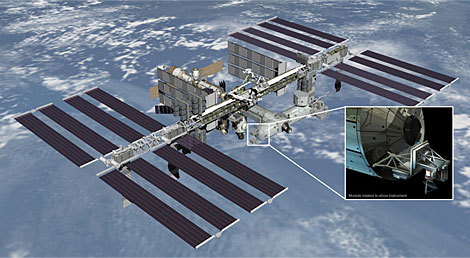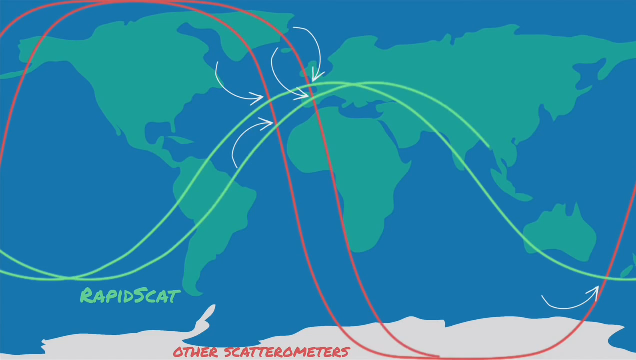Microwaves on guard of weather forecasts, or what is a scatterometer
It's no secret that the wind blows just because the trees are swinging. However, the guys from NASA JPL (and not only them) decided to go further than the hero of the famous comedy "Business People", and successfully study the wind directly from space. How? I’ll tell you about it under the cut.

According to my personal tradition, I am attaching a video that I translated and voiced specifically for this article. Everything is explained in it as simple as possible and without unnecessary details.
A few words about the terminology: there are two practically equivalent concepts: reflectometry and scatterometry . However, I propose to call the study of the Earth’s surface from space precisely scatterometry, in order to avoid confusion during translations and adaptations.
In simple terms, scatterometry is a method of measuring the size and shape of an object (more often the relief of a surface) based on how the object reflects and scatters light. Therefore, a scatterometer is a microwave radar that “shells” the surface with beams of light and tries to catch the reflected rays.
Scatterometers can work both from space, for example, clinging to a satellite, and during air travel within the Earth’s atmosphere, comfortably placed under the belly of an airplane. Microwaves are used for scanning, so NASA employees jokingly call the devices “microwaves”.
It is worth noting that the instruments are calibrated for a long time and carefully: the errors in the measurement of reflected-scattered rays are very significant. That is why NASA plans to use existing scatterometers to expedite the calibration process for its latest device: RapidScat.
RapidScat is the most advanced and technologically advanced scatterometer, which is scheduled to be launched at the end of this year. SpaceX Dragon will deliver the device to the ISS, where it will begin to perform its main function - scanning the surface of oks and seas. There are no special requirements for the mission, but NASA has formed several goals for its "microwave".

RapidScat Attached to the International Space Station
RapidScat goals:
1) Create a new platform for the constellation of scatterometers
RapidScat should provide a new calibration platform that will improve the stability and accuracy of the data received by the rest of the scatterometers operating in Earth orbit.
2) Investigate the diurnal and semidiurnal wind cycles in the ocean, as well as the evaporation of water from the surface of the Earth.
3) Provide data for forecasting weather and sea storms, as well as data for the introduction of time cycles in space.
In addition to RapidScat, a whole constellation of scatterometers is also involved in wind research : the Seasat Scatterometer (SASS), launched in 1978, launched by the European Space Agency in 1991 European Remote-Sensing Satellite ERS-1, armed with Advanced Microwave Instrument (AMI) equipment , and launched after the first ERS-2 (1995). In 1996, NASA launched the first NASA Scatterometer (NSCAT).
The first scanning scatterometer launched by NASA, also known as ' SeaWinds ', went to work in 1999. It was followed in 2002 by NASDA ADEOS-2 . Another launch took place in 2006, when the European Space Agency sent ASCAT into orbit .
In addition, the Indian Space Agency launched its own spacecraft in 2009.

The intersection of the trajectories of scatterometers and the ISS
Thus, already at the end of this year, NASA expects to begin to solve the problems of meteorology and calibration of the entire constellation of vehicles.
The importance of such studies is due to the fact that we still call some of the physical phenomena "mysteries of nature."
Data from ocean scatterometers will help scientists better explore the interaction of the atmosphere and the ocean, ocean circulation, and their impact on weather conditions and the global climate.
These data can also be used to study unusual weather events such as El Niño , the long-term effects of deforestation, and changes in ice masses around the polar regions. All of these phenomena play a central role in regulating the global climate.
When writing this note, the following materials were used:
About Scatteromerty by NASA JPL
Ocean Wind program by NASA JPL
Scatterometer on Wikipedia
PS It would be nice to supplement the article about scatterometers in Wikipedia in Russian: the method itself, and the programs themselves, deserve more detailed attention.

According to my personal tradition, I am attaching a video that I translated and voiced specifically for this article. Everything is explained in it as simple as possible and without unnecessary details.
A few words about the terminology: there are two practically equivalent concepts: reflectometry and scatterometry . However, I propose to call the study of the Earth’s surface from space precisely scatterometry, in order to avoid confusion during translations and adaptations.
In simple terms, scatterometry is a method of measuring the size and shape of an object (more often the relief of a surface) based on how the object reflects and scatters light. Therefore, a scatterometer is a microwave radar that “shells” the surface with beams of light and tries to catch the reflected rays.
Scatterometers can work both from space, for example, clinging to a satellite, and during air travel within the Earth’s atmosphere, comfortably placed under the belly of an airplane. Microwaves are used for scanning, so NASA employees jokingly call the devices “microwaves”.
It is worth noting that the instruments are calibrated for a long time and carefully: the errors in the measurement of reflected-scattered rays are very significant. That is why NASA plans to use existing scatterometers to expedite the calibration process for its latest device: RapidScat.
RapidScat is the most advanced and technologically advanced scatterometer, which is scheduled to be launched at the end of this year. SpaceX Dragon will deliver the device to the ISS, where it will begin to perform its main function - scanning the surface of oks and seas. There are no special requirements for the mission, but NASA has formed several goals for its "microwave".

RapidScat Attached to the International Space Station
RapidScat goals:
1) Create a new platform for the constellation of scatterometers
RapidScat should provide a new calibration platform that will improve the stability and accuracy of the data received by the rest of the scatterometers operating in Earth orbit.
2) Investigate the diurnal and semidiurnal wind cycles in the ocean, as well as the evaporation of water from the surface of the Earth.
3) Provide data for forecasting weather and sea storms, as well as data for the introduction of time cycles in space.
In addition to RapidScat, a whole constellation of scatterometers is also involved in wind research : the Seasat Scatterometer (SASS), launched in 1978, launched by the European Space Agency in 1991 European Remote-Sensing Satellite ERS-1, armed with Advanced Microwave Instrument (AMI) equipment , and launched after the first ERS-2 (1995). In 1996, NASA launched the first NASA Scatterometer (NSCAT).
The first scanning scatterometer launched by NASA, also known as ' SeaWinds ', went to work in 1999. It was followed in 2002 by NASDA ADEOS-2 . Another launch took place in 2006, when the European Space Agency sent ASCAT into orbit .
In addition, the Indian Space Agency launched its own spacecraft in 2009.

The intersection of the trajectories of scatterometers and the ISS
Thus, already at the end of this year, NASA expects to begin to solve the problems of meteorology and calibration of the entire constellation of vehicles.
The importance of such studies is due to the fact that we still call some of the physical phenomena "mysteries of nature."
Data from ocean scatterometers will help scientists better explore the interaction of the atmosphere and the ocean, ocean circulation, and their impact on weather conditions and the global climate.
These data can also be used to study unusual weather events such as El Niño , the long-term effects of deforestation, and changes in ice masses around the polar regions. All of these phenomena play a central role in regulating the global climate.
When writing this note, the following materials were used:
About Scatteromerty by NASA JPL
Ocean Wind program by NASA JPL
Scatterometer on Wikipedia
PS It would be nice to supplement the article about scatterometers in Wikipedia in Russian: the method itself, and the programs themselves, deserve more detailed attention.
